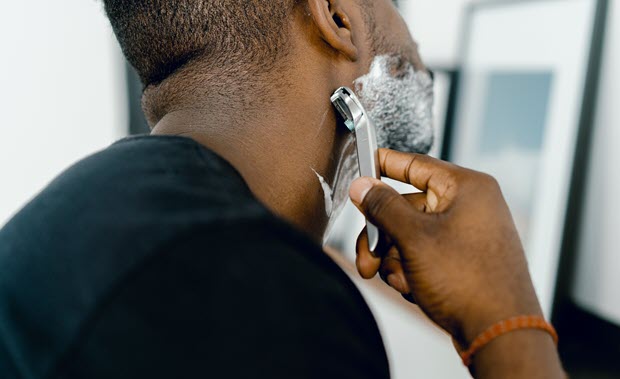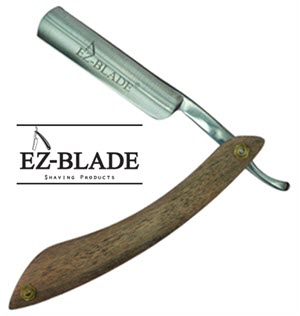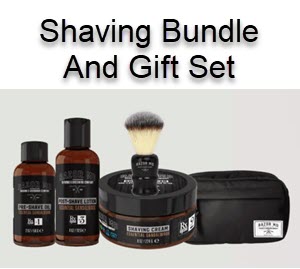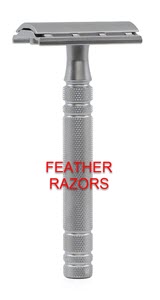How to Shave Your Neck: A Comprehensive Guide
Shaving the neck can be challenging in a grooming routine, yet mastering it is essential for a polished look. The skin on the neck is sensitive, and the hair can grow in varying directions, making it prone to razor burns and cuts. Here’s a guide to help you shave your neck effectively and safely.
Understanding the Intent Behind Neck Shaving
- Achieving a Clean and Even Shave: The primary goal is to remove hair cleanly without leaving patches or causing skin irritation.
- Preventing Razor Burns and Irritation: Due to the sensitivity of neck skin, using the correct technique and aftercare is crucial to avoid discomfort.
- Dealing with Different Hair Growth Patterns: Neck hair can grow in different directions, requiring specific techniques for a smooth shave.
Steps for a Perfect Neck Shave
Preparation is Key:
-
- Cleanse Your Skin: Begin with a warm shower or apply a towel to your neck. It will soften the hair and open up the pores.
- Apply a Good Quality Shaving Cream: Choose a cream suitable for sensitive skin and apply it generously
Choosing the Right Tools:
-
- Select a Sharp Razor: A sharp, multi-blade razor can provide a close shave with minimal irritation.
- Consider a Shaving Brush: It helps lift the hairs and evenly distribute the shaving cream.
Shaving Technique:
- Shave with the Grain: Shaving toward hair growth reduces irritation.
- Gentle Strokes: Use gentle strokes to avoid pressing too hard against the skin.
- Rinse the Blade Often: Keeping the blade clean ensures a smoother shave.
Handling Tricky Areas:
- Be Patient: Take your time around the Adam’s apple and other contours. Gently pull the skin to create a flat surface for easier shaving.
Aftercare:
- Rinse with Cold Water: This closes the pores and soothes the skin.
- Apply an Aftershave Balm: Choose an alcohol-free balm to moisturize and calm the skin.
Mastering the art of neck shaving is a matter of patience and meticulous technique. The key to a seamless, irritation-free shave is proper skin preparation, selecting appropriate tools, employing suitable shaving methods, and diligent post-shave skin care. It’s important to remember that hair growth patterns vary from person to person. Therefore, customizing your shaving routine to suit your unique skin and hair characteristics is essential for the best results.
Advanced Shaving Techniques: Elevating Your Grooming Game
Shaving is an art that goes beyond the primary drag of a razor across your face. For those looking to elevate their grooming routine, advanced shaving techniques offer a path to a closer, more satisfying shave. This article delves into the finer points of shaving, providing tips and methods to enhance your experience.
Understanding the Tools
- Straight Razors: The epitome of traditional shaving, straight razors offer unparalleled precision. They require skill and practice but reward you with a remarkably close shave. Learning to use and maintain a straight razor is a journey in itself.
- Safety Razors: These are a step up from your typical cartridge razors. Safety razors provide a close shave with less irritation and are economical in the long run due to their replaceable single blades.
Preparation: The Foundation of a Good Shave
- Pre-Shave Routine: Start with a facial scrub to exfoliate and prepare the skin. Pre-shave oils are also crucial, softening the beard and creating a protective layer over the skin.
- The Art of Lathering: Create a rich, creamy lather using a quality shaving cream and a badger hair brush. The brush lifts the hairs and ensures the lather coats each strand, providing a smoother glide for the razor.
Technique: The Heart of Advanced Shaving
- Angle and Pressure: Whether using a straight or safety razor, the angle you hold is crucial. A 30-degree angle is typically ideal. Use light pressure; let the weight of the razor do the work. With the Grain, Then Against Start by shaving with the grain to reduce the hair length. Then, carefully go against the grain on a second pass for an even closer shave. Be extra gentle to avoid irritation.
- Contouring: Pay special attention to the contours of your face, such as the jawline and neck area. Stretching the skin with your free hand can provide a flatter surface for a cleaner shave.
Post-Shave Care
- Rinse and Soothe: Rinse your face with cold water to close the pores after shaving. Apply an alcohol-free aftershave balm to soothe and moisturize the skin.
- Tool Maintenance: Keep your blades sharp and clean. For straight razors, strop before each use and hone as needed.
Advanced shaving techniques not only improve the quality of your shave but also turn it into a ritualistic experience. With the right tools, preparation, and skills, you can transform shaving from a daily chore into a satisfying, luxurious grooming session. Remember, practice makes perfect, and patience is vital in mastering these techniques.
Skin Care Post-Shaving: Essential Tips for Healthy Skin
Shaving, while a crucial part of many grooming routines, can be harsh on the skin. It can cause irritation, dryness, or razor burns, especially on sensitive skin. Proper post-shave skin care is essential to maintain healthy, smooth skin. This article provides simple yet effective tips for post-shaving skin care.
Understanding the Impact of Shaving on Skin
Shaving removes hair, strips away natural oils, and can cause micro-abrasions on the skin. It makes post shave skincare a cosmetic routine and a necessity for skin health.
Immediate Post Shave Care
- Rinse with Cold Water: Rinse your face with cold water after shaving. It helps close the pores and soothes the skin.
- Use a Hydrating Aftershave: Apply an alcohol-free aftershave balm or lotion. Products containing aloe vera, glycerin, or hyaluronic acid are great for moisturizing and soothing the skin.
Long-Term Skin Care Strategies
- Moisturize Face Daily: Keeping your skin hydrated is essential. Use a daily moisturizer that suits your skin type. For dry skin, creams with a thicker consistency are better, while oily skin benefits from lighter, water-based lotions.
- Sun Protection: Shaved skin is more vulnerable to sun damage. Daily sunscreen with at least SPF 30 protects your skin from harmful UV rays.
Dealing with Common Post-Shave Issues
- Razor Burns: If you experience razor burns, use aloe vera gel or cream to calm irritated skin.
- Ingrown Hairs: Prevent ingrown hairs by exfoliating your skin regularly with a gentle scrub. It keeps hair follicles clear, reducing the chance of hairs growing back into the skin.
Tips for Sensitive Skin
- Gentle Products: Use products formulated for sensitive skin, free from harsh chemicals and fragrances.
- Test New Products: Always do a patch test when trying a new product to ensure it doesn’t irritate your skin.
Effective post-shave skin care is essential for maintaining healthy, irritation-free skin. It’s not just about immediate relief but also about long-term skin health. Following these simple guidelines, you can protect and nourish your skin, keeping it smooth and comfortable after every shave.
Hair Growth Patterns and Management: to Understanding and Handling Your Hair
Hair growth patterns can significantly affect the ease of grooming and the final appearance after shaving or hair styling. This article provides insights into understanding hair growth patterns and offers tips for effective management.
Understanding Hair Growth Patterns
Hair growth patterns refer to the direction in which hair naturally grows. These patterns are most noticeable in areas like the scalp, beard, and neck. Variations in these patterns can lead to challenges in shaving, styling, and achieving a uniform look.
Recognizing Your Growth Patterns
- Observation is Key: Spend time examining the growth patterns of your hair, especially before shaving or styling. Look for the direction in which the hair lies flat or stands up.
- Please consult a Professional: Sometimes, it’s beneficial to talk with a barber or stylist who can provide insights into your unique hair growth patterns and offer advice on managing them.
Managing Hair Growth Patterns
Shaving Techniques:
- With the Grain: Shave toward hair growth for a less irritating shave. This technique is essential for those with sensitive skin.
- Against the Grain: Some may shave against the grain for a closer shave, but this should be done cautiously to avoid razor burns and ingrown hairs.
Hair Styling:
- Work with Your Pattern: Consider your natural growth pattern when styling hair. Staying in harmony with your pattern can be more effective than against it.
- Use the Right Products: Employ styling products that suit your hair type and help manage your specific growth pattern.
Tips for Specific Concerns
- Cowlicks: These are sections where hair grows in a swirl pattern. Manage cowlicks by cutting hair longer in these areas or using styling products for hold.
- Beard Growth: Uneven beard growth is expected. Regular trimming and beard care products can help maintain an even appearance.
- Ingrown Hairs: Occurs when hair curls back into the skin. Regular exfoliation and shaving with the grain can help prevent them.
Understanding and managing your hair growth patterns is crucial for effective grooming. Whether shaving or hair styling, working with your natural patterns instead of against them can lead to better results and less skin irritation. Observing your patterns, using the proper techniques, and employing suitable products can ensure a more comfortable and pleasing grooming experience.
Trends in Men’s Grooming: Staying Ahead in the Style Game
Men’s grooming has evolved significantly, with a growing focus on self-care and personal style. This article explores the latest trends in men’s grooming, offering insights into how modern men are shaping their grooming routines for a more polished and individualized look.
Embracing Natural Beard Styles
- Full and Textured Beards: The trend of sporting a full beard continues, with a shift towards more natural, textured looks. Men embrace their unique beard patterns, focusing on healthy growth and maintenance.
- Beard Oils and Balms: The use of beard oils and balms has surged, helping men keep their beards soft, hydrated, and well-groomed.
Personalized Skincare Routines
- Tailored Skincare: Men increasingly adopt skincare routines tailored to their skin type and concerns, moving beyond essential cleansing.
- Anti-Aging and Sun Protection: There’s a growing awareness about anti-aging products and the importance of sun protection as part of the daily grooming regimen.
Eco-Friendly and Sustainable Products
- Natural Ingredients: There is a shift towards grooming products with raw, organic ingredients, avoiding harsh chemicals.
- Sustainable Practices: Men opt for brands that demonstrate sustainability in their production and packaging, reflecting a commitment to environmental responsibility.
Advanced Hair Care
- Specialized Hair Products: The use of specialized hair products, such as serums, leave-in conditioners, and masks, focusing on hair health and styling is on the rise.
- Bold Hair Colors: More men are experimenting with hair coloring, choosing bold and unconventional colors.
Tech-Integrated Grooming Tools
- Smart Grooming Gadgets: High-tech grooming tools, including advanced electric razors and trimmers with multiple settings, are becoming popular for their precision and convenience.
- Skin Analysis Tools: Devices that analyze skin type and health, guiding men in choosing the right skincare products, are gaining traction.
Conclusion
Men’s grooming is no longer just about a quick shave and a haircut. It’s about expressing individuality and taking care of oneself. From embracing natural beard styles to personalized skincare and eco-friendly products, the trends in men’s grooming reflect a broader shift towards holistic self-care and sustainability. Keeping up with these trends ensures you look your best and feel great about your grooming choices.
- Bakblade 2.0: The Ultimate Solution for Back Hair Removal
- Best Ball Shaver for Sensitive Skin – 2024 Picks
- The Shaving Gel Hack That Beauty Gurus Don’t Want You to Know About!
- Henson Shaving: Where Design Meets Durability and Performance
- Caramel Honey Blonde Hair: Elevate Your Look
- Feather Razors: Precision Shaving for Every Skin Type
- Straight Razor Shaving: Unlocking a Closer, Smoother Shave
- Premium Safety Razors: Your Guide to Quality Shave
- Pros & Cons: Shaving Against the Grain Guide
- Maximize Your Shave: Norelco Sensotouch 3d Razor
- Best Aftershave for Men: Elevate Your Grooming
- Where to Buy A Straight Razor: Expert Stores & Online Tips
- Elevate Your Grooming Game with a Premium Shaving Kit
- Unlock Shine: The Ultimate Hydrating Cleansing Conditioner
- Styptic Pencils: Quick Fix for Minor Bleeds & Nicks
- Panasonic Men’s Shaver: Experience The Future
- Pre Shave Oil: Reduce Nicks & Razor Burn
- Van Der Hagen shaving soap review: A Closer Look
- Scuttle Shaving: Unlocking the Secret to a Perfect Shave
- Ogallala Bay Rum: A Timeless Scent for the Modern Gentleman
- Best Double Edge Razors: A Cut Above the Rest
- Master the Art of Shaving: Your Guide to Buying a Straight Razor
- How To Sharpen Electric Razor Blades: Quick Guide
- The Benefits of Aftershave: It’s Skin Care
- Secure & Stylish: Choosing the Best Travel Razor Case
- Master the Art of Shaving with Adjustable Safety Razors
- The Best Safety Razors You Can Find for a Superior Shave
- Cremo Shaving Cream: For the Ultimate Shave
- Simpson Shaving Brush: Your Best Shave Awaits!
- The Secret to a Perfect Shave? Unveiling the Edwin Jagger Safety Razor





